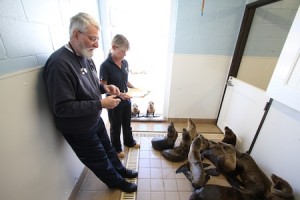
Last weekend, three sick sea lion pups came up on the shore and rocks below Laguna Beach’s Heisler Park and a dog that had broken free of its owner’s leash attacked another near the Treasure Island tide pools below the Montage resort. The injured young sea lion later died due to the inflicted wounds, according to police reports.
Tidepool educators from Laguna Ocean Foundation called rescue workers at the Pacific Marine Mammal Center in Laguna Canyon for help. On Sunday alone, seven in all were rescued along Laguna’s coast.
One of the sea lion pups, likely a yearling stranded Friday on the rocks at Rockpile beach below Heisler Park, was convulsing and throwing up blood, too sick to hope for survival. Another younger pup dragged itself back into the sea, a sure path to demise in its weakened condition, before rescuers could arrive.
Yet another pup tried to keep itself on a tidepool-rock ledge before help arrived while tidepool educators kept the curious and their dogs at bay.
The sea lion pup was the seventh rescue in a day that took PMMC volunteers and staff to Seal Beach and Huntington Beach before heading back down to Laguna, drained by the physically demanding work of climbing rocks and lifting pups from craggy crevices. This pup’s nozzle was gently wrapped in a blanket to prevent panic-biting before the rescuer carried its docile body up a long flight of beach-access stairs at the south end of Heisler Park.
At least 20 more pups were rescued in the first three days of this week, according to the center, with 100 rescue calls coming into the center on Monday alone. On Tuesday, 15 sea lion pups in more stable condition were trucked to The Marine Mammal Center in Sausalito to provide room for incoming pups at the center here, according to Melissa Sciacca, media spokesperson for PMMC.
More than 144 sea lion pups have been rescued in Orange County since the epidemic started in January, according to Jim Beres, who oversees the city‘s animal rescue services. Of that number, some died while others regained their health and were released to the sea.
The center has declared a “state of emergency.” Food, medication and supplies needed to care for the onslaught of sick young pinnipeds are dwindling, according to the center, and demands on time, energy and space are increasing. The majority of the rescues are severely malnourished, dehydrated and significantly underweight for their age, according to Michele Hunter, PMMC’s director of animal care.
Most of the pups are eight to nine months old, normally weighing about 60 pounds. The malnourished and dehydrated pups, 30 to 40 pounds underweight, require two to four months of care before they’re again sea-worthy.
“This requires a great deal of resources, including space, funds for medicine and food, medical staff time and vehicle transportation to and from the beaches,” said Hunter.
Scientists, researchers and field experts are gathering data to determine why the pups are not being nourished by their mothers and found stranded on beach and rocks. Possible causes include anomalies such as ocean acidification due to increased carbon dioxide levels, ocean pollutants from urban run-off, overfishing and navigational pattern changes in the fish that provide sea lions sustenance.
During the weaning stage of sea lion pups, mothers are often pregnant with the next pup, explained Jim Oswald, spokesperson for The Marine Mammal Center in Sausalito. If the mothers are sick themselves from exposure to a toxin, such as the neurotoxin domoic acid found in harmful algae blooms, they will be unable to nurse the pups until they are fully weaned, leaving them stranded and unable to feed on their own.
Sarah Wilkin, marine mammal stranding coordinator at the National Marine Fisheries Service’s Long Beach office, said it will take months before anything definitive will be known.
“It’s an extreme event,” said Steven Murray, international authority on coast marine ecosystems and dean of natural sciences and mathematics at California State University, Fullerton. “There’s a huge food shortage.”
But other researchers disagree. “It would take decades before worrying about food supply for the marine mammals,” said Steve Weisberg, executive director of the Southern California Coastal Water Research Council. Dave Caron, professor of biological sciences at USC and an expert in toxic algaes, said he doesn’t see a link between harmful algaes and the starvation epidemic in sea lion pups.
PMMC is asking anyone who comes across a sick pup to back away and immediately call the center at 494-3050. Keith Matassa, PMMC executive director, said there’s been too many people chasing the animals back into the water, the worst thing, he said, that can happen to a sick sea mammal.
“These pups are coming ashore to get warm and rest, and are hauling out of the ocean to survive,” he said. “We encourage the public to keep their distance, call us to help identify the animal and location, and keep others away until we arrive. This will give us the best possible chance to assist these pups that need our help.
The center is accepting donations of time and supplies to help care for the recent onslaught of sick sea lion pups. “With this high number of animals, we are going through our financial resources at an alarming rate,” said Matassa. “Every dollar counts, and anyone able to support us during this time is greatly appreciated.”





[…] Hunter. Their condition is similar to that of two years ago when the center rescued more than 200 starving pups. The rehabilitation facility on Laguna Canyon Road was filled to capacity, leading federal wildlife […]